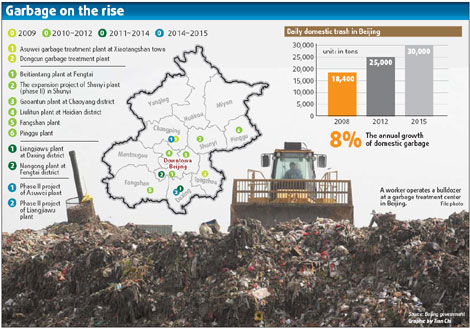Beijing will build or renovate more than 40 garbage disposal plants by 2015 to meet the growing amount of waste generated in the capital, authorities said yesterday.
The projects include five domestic waste incineration plants, five kitchen waste disposal plants and eight domestic waste comprehensive treatment plants, according to the government report.
Vice-Mayor Huang Wei will deliver the report tomorrow at an ongoing session of the standing committee of the Beijing municipal people's congress.
The new and improved facilities are expected to handle 30,000 tons of garbage a day, the report said.
"Beijing is facing a grave challenge in treating its garbage," the report said.
The volume of waste generated by the city increases 8 percent every year, with last year's number standing at 18,000 tons of domestic trash on average per day.
The number is expected to reach 25,000 tons in 2012 and 30,000 tons in 2015.
The capital's 23 domestic garbage treatment facilities are capable of processing 10,400 tons of waste a day, but in reality, the facilities are handling more than 17,400 tons of trash per day.

Since the garbage facilities are working beyond their capacity, the life of each processing plant will likely be cut in half, the report said.
"With rapid urbanization, industrialization and modernization, the city's urgent task is to enhance full-scale garbage treatment and recycling work," the report said.
Another challenge is the shortage of garbage incineration facilities. Most developed countries choose incineration instead of landfill.
For example, more than 90 percent of the garbage in Japan is incinerated. In Shanghai, 15 percent of its garbage is incinerated, and in Shenzhen, 40 percent is burned.
By contrast, in Beijing only 2 percent of domestic garbage is incinerated and more than 90 percent goes to landfills.
"Landfills not only require a number of land areas each year, they also add new difficulties due to the control of sites' pollution," the report said.
Biotreatment is another method of treating garbage, in which certain garbage materials are transformed into fertilizer. City officials would like to increase the amount of trash that is biotreated.
According to the report, the new facilities will enormously increase Beijing's garbage incineration capacity. The proportion of incineration, bio-treatment and landfill will reach 2:3:5 in 2012 and 4:3:3 in 2015.
Zhao Yi, deputy director general with the urban construction and environment protection committee of the congress, said: "Garbage incineration technologies have become very mature after years of development. The city should promote the facilities' construction and enhance modernization of garbage treatment."
(China Daily July 24, 2009)